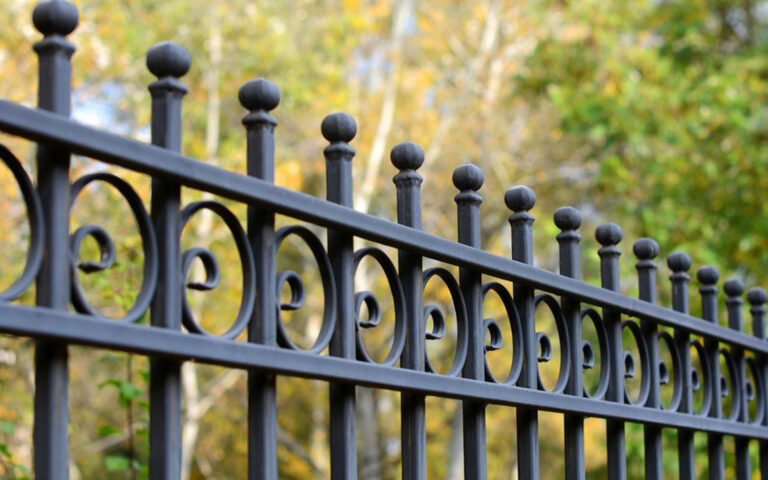Some of the nearby residences are surrounded by welded iron fences. You may be surprised to hear that wrought iron fences come in a wide variety. While some people like sleek, modern fences, others value straightforward, plain fences.
It’s important to be aware of the many indoor and outdoor wrought iron fence in Boise that Boise offers. If you know what to look for and where to look, you can find a gorgeous fence in the yard. You will discover wrought iron fencing’s rich and intriguing history, as well as its historical significance.
History of Wrought Iron Gates
The first wrought iron railings were not constructed until the fourteenth century, despite the fact that blast furnaces were needed for their production. Churches and other places of worship, including temples, were where some of the first discoveries were discovered. Although steel was widely available at the time, wrought iron remained a common building material until the late 1800s. Cast iron railings were used extensively for the first time in the second half of the 18th century. This was a direct effect of new production techniques being developed in the middle of the century.
The Adams brothers played a significant role in the development of cast iron, and they may also share some of the responsibility for its widespread usage. They discovered almost on that metal could be easily molded using very basic methods into identifiable forms. However, cast iron was seldom ever used as an outside decorative feature until about 1850. During the Victorian era, cast iron had a spike in popularity, and architects often used it to design Victorian gates, railings, panels, and the decorative accents that went with them. The 20th century saw several manifestations of this tendency.
Victorian villas sometimes had tiled walls, gates, and garden walkways created as a method to demonstrate the affluence of their owners. These palaces were often large and opulent.
Both cast iron and wrought iron are useful in a variety of situations. On some terraced homes from the Victorian period, gates and fences that improve occupant safety and distinguish private property from public streets may still be present.
Historic ironwork is often utilized as a decorative feature, balustrade or railing, terrace gate, or other architectural element to accentuate the structure. As a result, the building’s overall aesthetic appeal has increased. Some commentators claim that the style first emerged during the “gentle phase” of Victorian workmanship, which witnessed the deliberate creation of exquisitely crafted objects. This is a consequence of the purposeful creation of beautiful, high-quality items throughout this time. This is a consequence of the fact that objects have historically been painstakingly crafted with fine designs. Cast iron fences, and gates became more popular as a direct result.
Dome-Topped
The tops of a handful of the older wrought iron fences resemble rounded arches. They could give the inside of your house a more neo-classical or Victorian vibe. It is now commonly accepted that adding a fence with an arched top will make a home seem more attractive. These fences are made by connecting parallel rows of vertical posts to form an arc, often known as a half circle. It can serve a variety of customers since the layout may be altered to better suit their needs.
Coverings Made of Metal
As stated by the name of the fence, this kind of wrought iron fence may be recognized by the close spacing between the vertical posts. It is obvious to concentrate on these areas. Even if a metal gate is built, there won’t be a way to peek through it after it is complete since the area between the rails would be filled. This is a fantastic choice to take into account if you want to give your yard a feeling of remoteness. To choose a design that will satisfy your needs, it is crucial to explore your possibilities with a fence builder.
Decorated Wrought Iron Fences
This wrought iron fence may have a number of embellishments put to it to enhance its visual appeal. These designs include logos, arches, and medallions. As talented artisans began carving eye-catching designs onto the fenceposts, demand for ornate wrought iron fences increased. In addition to other alterations, homeowners who choose this option are allowed to add their own artwork and logos on the gates. There are many different ways to beautify wrought iron fences, including powder coating.
Setting Up a Basic Iron Fence
Straight-topped arched arches in wrought-iron fences look nice and have a function. This ironwork’s simple yet intricate design is often used in the security sector. The finials on the fenceposts give the fence the appearance of having an arrowhead form.
Any kind of wrought iron fence, whether it is residential or commercial, will improve the appearance of your property. You must include a landscaping element for the garden during the next stage of development. Once the modifications are finished, the area will be much more appealing and will resemble a little paradise.
Installing Advice
A wrought iron fence, which has many utilitarian uses as well, may add to a home’s visual appeal. Wrought iron fences are often built all around important sites, including institutions, businesses, and opulent home construction projects. Consider the advantages that wrought iron fences provide as you learn more about the various fence types.
Your wrought iron fence’s strength and level of isolation will be affected by a number of elements, including its design and height. When combined with thick foliage, wrought iron fences with unusual patterns run the risk of obscuring your view from within your property.
One of the most efficient types of perimeter security is a wrought iron fence, which is hard to climb. The best defense for your home and garden is to install a high, evenly-spaced wrought-iron fence around the outside of your property.
The best fence material is wrought iron since it requires far less upkeep than wood or PVC alternatives. The only thing necessary to preserve its look is to paint the surface a few times every few years since it is extremely resistant to the effects of weathering. A wrought iron fence has a substantially longer lifetime than other types of fencing.
Additionally, wrought iron fences need a lot less routine upkeep than wooden fences do. It will be considerably simpler to replace or repair the damaged or misplaced portion of the fence if just a small portion of the fence is compromised. The fence will very probably need to be repaired if there is any damage.
Since they are easy to recycle or reuse if they need to be repaired or rebuilt, wrought iron fences are often seen as an environmentally responsible alternative. Since it is strong and long-lasting, changing it every few years doesn’t cost anything. Fences made of wrought iron are exceedingly strong and seldom collapse. Even yet, it often has an unmatched degree of durability.
Conclusion
Wrought iron fences used to be a symbol of wealth and accomplishment, but those times are long gone. These fences are now commonly made available for purchase by a range of consumers due to their inexpensive cost. Their longevity is another trait that adds to their extensive usage in the real estate sector. If you want to build a wrought-iron fence around your home, get advice from a professional before you start. If you’re interested in learning more about fencing, click here.


